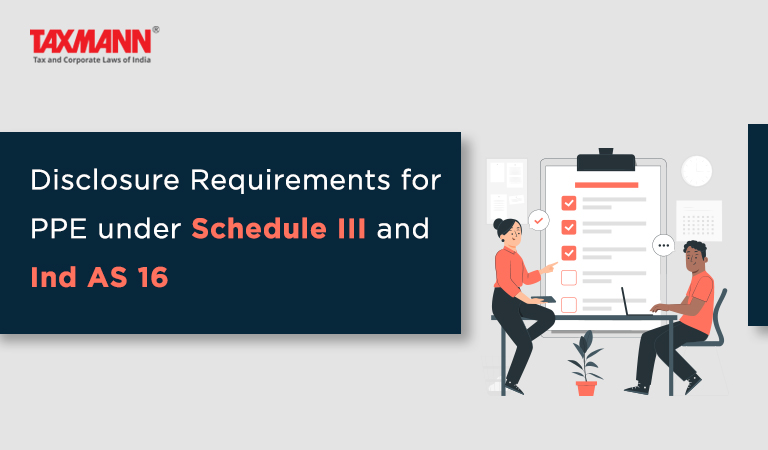Disclosure Requirements for PPE under Schedule III and Ind AS 16
- Blog|News|Account & Audit|
- 2 Min Read
- By Taxmann
- |
- Last Updated on 25 February, 2023
Part I of Division II of Schedule III to Companies Act 2013 which is applicable to Financial Statements for a company whose financial statements are required to be drawn up in compliance of the Companies (Indian Accounting Standards) Rules, 2015 prescribes the following line items are to be presented one the face of the Balance Sheet in relation to Non-current assets in the format discussed in the story.
1. Disclosure requirement under Schedule III
a. Classification shall be given as Land, Buildings, Plants and Equipment, Furniture & Fixtures, Vehicles, Office Equipment, Bearer Plant, and others (specify nature).
b. Assets under the lease shall be separately specified under each class of assets
c. A reconciliation of the gross and net carrying amounts of each class of assets at the beginning and end of the reporting period
2. Key Points to be considered while reporting under Property, Plant and Equipment:
Key points considered by FRRB relating to presentation and disclosure of property, plant & equipment (PPE) in Ind AS financial statements.
a. Accounting Policy:
“Subsequent expenditure related to an item of PPE is added to its carrying value only if it increases the future benefits from the existing asset beyond its previously assessed standard of performance”
b. Relevant Provisions: Para 7 of Ind AS 16, PPE
The cost of an item of property, plant and equipment shall be recognized as an asset if, and only if: (a) it is probable that future economic benefits associated with the item will flow to the entity; and (b) the cost of the item can be measured reliably.
Para 13 of Ind AS 16, PPE
…Under the recognition principle in paragraph 7, an entity recognizes in the carrying amount of an item of property, plant and equipment the cost of replacing part of such an item when that cost is incurred if the recognition criteria are met.
c. FRRB Observation: FRRB of ICAI is of the view that is no criterion that capitalisation should be done only if there is increase of future benefits from the existing asset beyond previously assessed standard of performance. The language of the stated policy is not in line with the component accounting concepts given in Ind AS 16.
3. Relevant extracts of the Accounting policy of Asian Paints Ltd and Notes to Financials on PPE of ITC Ltd. is discussed in the story.
Click Here To Read The Full Story
Disclaimer: The content/information published on the website is only for general information of the user and shall not be construed as legal advice. While the Taxmann has exercised reasonable efforts to ensure the veracity of information/content published, Taxmann shall be under no liability in any manner whatsoever for incorrect information, if any.

Taxmann Publications has a dedicated in-house Research & Editorial Team. This team consists of a team of Chartered Accountants, Company Secretaries, and Lawyers. This team works under the guidance and supervision of editor-in-chief Mr Rakesh Bhargava.
The Research and Editorial Team is responsible for developing reliable and accurate content for the readers. The team follows the six-sigma approach to achieve the benchmark of zero error in its publications and research platforms. The team ensures that the following publication guidelines are thoroughly followed while developing the content:
- The statutory material is obtained only from the authorized and reliable sources
- All the latest developments in the judicial and legislative fields are covered
- Prepare the analytical write-ups on current, controversial, and important issues to help the readers to understand the concept and its implications
- Every content published by Taxmann is complete, accurate and lucid
- All evidence-based statements are supported with proper reference to Section, Circular No., Notification No. or citations
- The golden rules of grammar, style and consistency are thoroughly followed
- Font and size that’s easy to read and remain consistent across all imprint and digital publications are applied






 CA | CS | CMA
CA | CS | CMA


